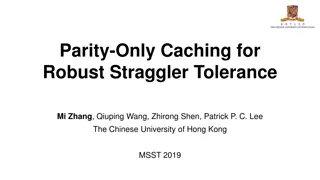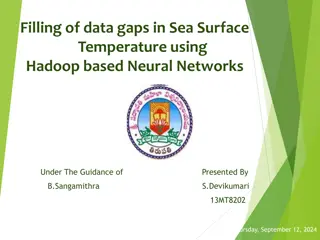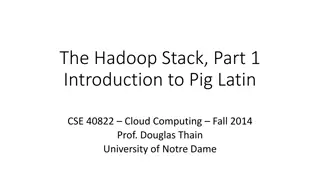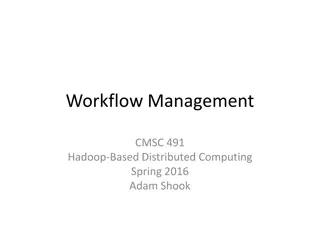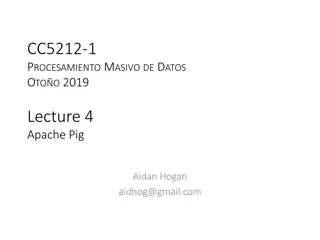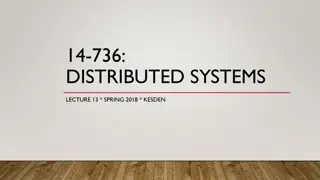
Overview of Hadoop in Cloud Computing
Dive into the world of Hadoop with this comprehensive overview covering its advantages, core components, related subprojects, and the essential role of YARN in enterprise Hadoop implementations.
Download Presentation

Please find below an Image/Link to download the presentation.
The content on the website is provided AS IS for your information and personal use only. It may not be sold, licensed, or shared on other websites without obtaining consent from the author. If you encounter any issues during the download, it is possible that the publisher has removed the file from their server.
You are allowed to download the files provided on this website for personal or commercial use, subject to the condition that they are used lawfully. All files are the property of their respective owners.
The content on the website is provided AS IS for your information and personal use only. It may not be sold, licensed, or shared on other websites without obtaining consent from the author.
E N D
Presentation Transcript
Introduction to Cloud Computing Lecture 4-2 Hadoop Overview
Why Hadoop? Big Data!! Storage Analysis Data management
Advantages of Hadoop Vast amounts of data Economic Efficient Scalable Reliable
Applications not for Hadoop Low-latency data access HBase is currently a better choice Lots of small files All filesystem metadata is in memory The number of files is constrained by the memory size of the name node Multiple writers, arbitrary file modifications
The Core Apache Hadoop Project Hadoop Common: Java libraries and utilities required by other Hadoop modules. Hadoop YARN: a framework for job scheduling and cluster resource management. HDFS: A distributed file system Hadoop MapReduce: YARN-based system for parallel processing of large data sets.
Hadoop Cluster Typically in 2 level architecture Nodes are commodity PCs 30-40 nodes/rack Uplink from rack is 3-4 gigabit Rack-internal is 1 gigabit Aggregation switch Rack switch
Hadoop Related Subprojects Pig High-level language for data analysis HBase Table storage for semi-structured data Zookeeper Coordinating distributed applications Hive SQL-like Query language and Metastore Mahout Machine learning
Yarn YARN is the prerequisite for Enterprise Hadoop providing resource management and a central platform to deliver consistent operations, security, and data governance tools across Hadoop clusters.
YARN Cluster Basics In a YARN cluster, there are two types of hosts: The ResourceManager is the master daemon that communicates with the client, tracks resources on the cluster, and orchestrates work by assigning tasks to NodeManagers. A NodeManager is a worker daemon that launches and tracks processes spawned on worker hosts.
Yarn Resource Monitoring (i) YARN currently defines two resources: v-cores memory. Each NodeManager tracks its own local resources and communicates its resource configuration to the ResourceManager The ResourceManager keeps a running total of the cluster s available resources. 11
Yarn Resource Monitoring (ii) 100 workers of same resources 12
Yarn Container Containers a request to hold resources on the YARN cluster. a container hold request consists of vcore and memory Container as a hold The task running as a process inside a container 13
Yarn Application and ApplicationMaster Yarn application It is a YARN client program that is made up of one or more tasks Example: MapReduce Application ApplicationMaster It helps coordinate tasks on the YARN cluster for each running application It is the first process run after the application starts. 14
Interactions among Yarn Components (i) 1. The application starts and talks to the ResourceManager for the cluster 15
Interactions among Yarn Components (ii) 2. The ResourceManager makes a single container request on behalf of the application 16
Interactions among Yarn Components (iii) 3. The ApplicationMaster starts running within that container 17
Interactions among Yarn Components (iv) 4. The ApplicationMaster requests subsequent containers from the ResourceManager that are allocated to run tasks for the application. Those tasks do most of the status communication with the ApplicationMaster allocated in Step 3 18
Interactions among Yarn Components (v) 5. Once all tasks are finished, the ApplicationMaster exits. The last container is de-allocated from the cluster. 6. The application client exits. (The ApplicationMaster launched in a container is more specifically called a managed AM. Unmanaged ApplicationMasters run outside of YARN s control.) 19
Goals of HDFS Very Large Distributed File System 10K nodes, 100 million files, 10 PB Assumes Commodity Hardware Files are replicated to handle hardware failure Detect failures and recovers from them Optimized for Batch Processing Data locations exposed so that computations can move to where data resides Provides very high aggregate bandwidth User Space, runs on heterogeneous OS
The Design of HDFS Single Namespace for entire cluster Data Coherency Write-once-read-many access model Client can only append to existing files Files are broken up into blocks Typically 64MB-128MB block size Each block replicated on multiple DataNodes Intelligent Client Client can find location of blocks Client accesses data directly from DataNode
Functions of a NameNode Manages File System Namespace Maps a file name to a set of blocks Maps a block to the DataNodes where it resides Cluster Configuration Management Replication Engine for Blocks To ensure high availability, you need both an active NameNode and a standby NameNode. Each runs on its own, dedicated master node.
NameNode Metadata Metadata in Memory The entire metadata is in main memory No demand paging of metadata Types of metadata List of files List of Blocks for each file List of DataNodes for each block File attributes, e.g. creation time, replication factor A Transaction Log Records file creations, file deletions etc
Secondary NameNode Copies FsImage and Transaction Log from Namenode to a temporary directory Merges FSImage and Transaction Log into a new FSImage in temporary directory Secondary Namenode whole purpose is to have a checkpoint in HDFS Uploads new FSImage to the NameNode Transaction Log on NameNode is purged
DataNode A Block Server Stores data in the local file system (e.g. ext3) Stores metadata of a block (e.g. CRC) Serves data and metadata to Clients Block Report Periodically sends a report of all existing blocks to the NameNode Facilitates Pipelining of Data Forwards data to other specified DataNodes
Block Placement Current Strategy One replica on local node Second replica on a remote rack Third replica on same remote rack (default: 3 replicas) Additional replicas are randomly placed Clients read from nearest replicas
Heartbeats DataNodes send hearbeat to the NameNode periodically Once every 3 seconds NameNode uses heartbeats to detect DataNode failure
NameNode as a Replication Engine NameNode detects DataNode failures Chooses new DataNodes for new replicas Balances disk usage Balances communication traffic to DataNodes
Data Correctness Use Checksums to validate data Use CRC32 File Creation Client computes checksum per 512 bytes DataNode stores the checksum File access Client retrieves the data and checksum from DataNode If Validation fails, Client tries other replicas
Data Pipelining (i) Client retrieves a list of DataNodes on which to place replicas of a block Client writes block to the first DataNode The first DataNode forwards the data to the next node in the Pipeline When all replicas are written, the Client moves on to write the next block in file
Rebalancer Goal: % disk full on DataNodes should be similar Usually run when new DataNodes are added Cluster is online when Rebalancer is active Rebalancer is throttled to avoid network congestion Command line tool
User Interface Commads for HDFS User: hadoop dfs -mkdir /foodir hadoop dfs -cat /foodir/myfile.txt hadoop dfs -rm /foodir/myfile.txt Commands for HDFS Administrator hadoop dfsadmin -report hadoop dfsadmin -decommision datanodename Web Interface http://host:port/dfshealth.jsp
MapReduce - What? MapReduce is a programming model for efficient distributed computing It works like a Unix pipeline cat input | grep | sort | uniq -c | cat > output Input | Map | Shuffle & Sort | Reduce | Output Efficiency from Streaming through data, reducing seeks Pipelining A good fit for a lot of applications Log processing Web index building
MapReduce - Features Fine grained Map and Reduce tasks Improved load balancing Faster recovery from failed tasks Automatic re-execution on failure In a large cluster, some nodes are always slow or flaky Framework re-executes failed tasks Locality optimizations With large data, bandwidth to data is a problem Map-Reduce + HDFS is a very effective solution Map-Reduce queries HDFS for locations of input data Map tasks are scheduled close to the inputs when possible
Word Count Example Mapper Input: value: lines of text of input Output: key: word, value: 1 Reducer Input: key: word, value: set of counts Output: key: word, value: sum Launching program Defines this job Submits job to cluster
Hadoop-MapReduce Workflow input HDFS output HDFS sort/copy map merge split 0 reduce part0 split 1 split 2 map split 3 split 4 reduce part1 map
Example I am a tiger, you are also a tiger I,1 am,1 a,1 a,2 also,1 am,1 are,1 map a, 1 a,1 also,1 am,1 are,1 I,1 tiger,1 tiger,1 you,1 reduce part0 tiger,1 you,1 are,1 map I, 1 tiger,2 you,1 part1 also,1 a, 1 tiger,1 reduce map JobTracker generates three TaskTrackers for map tasks JobTracker generates two TaskTrackers for map tasks Hadoop sorts the intermediate data 43
Input and Output Formats A Map/Reduce may specify how it s input is to be read by specifying an InputFormat to be used A Map/Reduce may specify how it s output is to be written by specifying an OutputFormat to be used These default to TextInputFormat and TextOutputFormat, which process line-based text data Another common choice is SequenceFileInputFormat and SequenceFileOutputFormat for binary data These are file-based, but they are not required to be
How many Maps and Reduces Maps Usually as many as the number of HDFS blocks being processed, this is the default Else the number of maps can be specified as a hint The number of maps can also be controlled by specifying the minimum split size The actual sizes of the map inputs are computed by: max(min(block_size,data/#maps), min_split_size) Reduces Unless the amount of data being processed is small 0.95*num_nodes*mapred.tasktracker.tasks.maximum
Some handy tools Partitioners Combiners Compression Counters Speculation Zero Reduces Distributed File Cache Tool
Partitioners Partitioners are application code that define how keys are assigned to reduces Default partitioning spreads keys evenly, but randomly Uses key.hashCode() % num_reduces Custom partitioning is often required, for example, to produce a total order in the output Should implement Partitioner interface Set by calling conf.setPartitionerClass(MyPart.class) To get a total order, sample the map output keys and pick values to divide the keys into roughly equal buckets and use that in your partitioner
Combiners When maps produce many repeated keys It is often useful to do a local aggregation following the map Done by specifying a Combiner Goal is to decrease size of the transient data Combiners have the same interface as Reduces, and often are the same class Combiners must not have side effects, because they run an intermdiate number of times In WordCount, conf.setCombinerClass(Reduce.class);
Compression Compressing the outputs and intermediate data will often yield huge performance gains Can be specified via a configuration file or set programmatically Set mapred.output.compress to true to compress job output Set mapred.compress.map.output to true to compress map outputs Compression Types (mapred(.map)?.output.compression.type) block - Group of keys and values are compressed together record - Each value is compressed individually Block compression is almost always best Compression Codecs (mapred(.map)?.output.compression.codec) Default (zlib) - slower, but more compression LZO - faster, but less compression
Counters Often Map/Reduce applications have countable events For example, framework counts records in to and out of Mapper and Reducer To define user counters: static enum Counter {EVENT1, EVENT2}; reporter.incrCounter(Counter.EVENT1, 1); Define nice names in a MyClass_Counter.properties file CounterGroupName=MyCounters EVENT1.name=Event 1 EVENT2.name=Event 2






